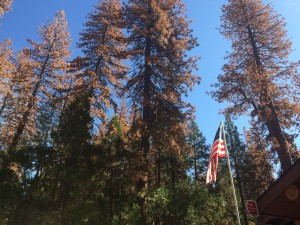 A new study by the Proceedings of the National Academy of Sciences indicates that human mismanagement of forest lands in the Sierra Nevada has been the primary culprit in increasingly severe forest fires — not climate change.
A new study by the Proceedings of the National Academy of Sciences indicates that human mismanagement of forest lands in the Sierra Nevada has been the primary culprit in increasingly severe forest fires — not climate change.
The research team used the fire history recorded in tree rings from 29 sites in the Sierra Nevada, combined with records of annual areas burned from 1600 to last year. The scientists then plotted this 415-year history against past environmental records of temperature and moisture.
The authors found four big periods:
- The Native American time with regular prescribed burns that limited devastating fires by reducing fuel loads
- The Mission period, when the European invasion of Native lands began and disrupted the prescribed burns, building up the fuel loads and leading to more fires
- The Gold Rush period, when more outsiders invaded and brought grazing species that kept down the fuel loads
- The post-1904 period when current fire suppression practices began; they led to the build up of fuel loads and the worsening of fires in a warming climate since 1980
So what can we do about the situation now?
As KQED reports, the study authors recommend dramatic forest management changes that hearken back to the original Native practices:
Prescribed burning is one way to do that and needs to be emphasized, she said, adding, “Now we know that burning not only helps with fuel loads; it also helps to reduce the effects of climate on fire.”
Land managers are increasing their use of prescribed burns as agency officials and the general public understand their importance. But 150 years of low activity and suppression have left an enormous fire deficit, said Thomas. To maintain healthy forests, where flames char trees without widespread destruction, Sierra Nevada land managers need to burn 500,000 acres (200,000 hectares) every year, he said. Current managed ignitions total less than 40,000 acres (16,000 hectares) through California, Thomas said.
“We desperately need to burn tens of thousands of acres on every forest in the Sierra Nevada – every year,” he said.
It would be a big change that would cost money and significant resources. But the alternative of doing too little will be costly as well, particularly in our new era of climate change.
Leave a Reply
You must be logged in to post a comment.


